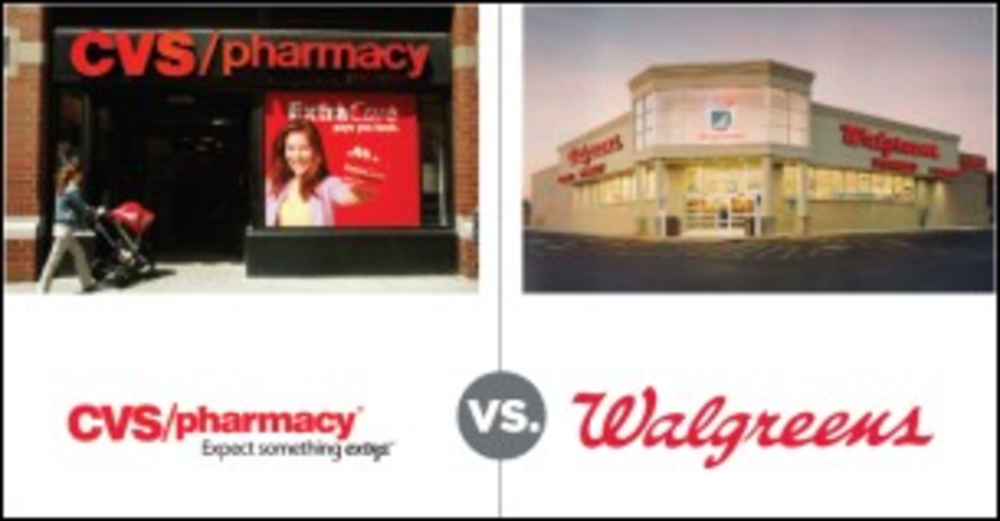CVS Caremark
$98.7B annual revenues
7,196 locations
Walgreens
$67.4B annual revenues
8,136 locations
As consumers are faced with rising healthcare costs, competition among the country’s leading drugstore chains, CVS and Walgreens, has increased, fueling sector-wide acquisitions and dueling marketing campaigns. To keep up, these companies are vying for loyalty in their pharmacies, as well as diversifying their brand messaging to promote their other retail offerings such as beauty products and photo developing.
Walgreens and third competitor Rite Aid both launched loyalty programs in 2010. While CVS’ ExtraCare loyalty program has been around since 2001, the retailer expanded its loyalty foothold by launching the ExtraCare Beauty Club in January.
“The drugstore space has become a really hot area right now in terms of loyalty programs,” says Kelly Hlavinka, partner at Colloquy, a firm that specializes in loyalty marketing. “There has been consolidation in the industry, which makes it a lot more competitive, and loyalty programs help these marketers gain the edge.” (Walgreens acquired Duane Reade last year; CVS acquired Longs Drug Stores in 2008 and finished its Caremark acquisition in 2007, which greatly increased its pharmacy program.)
CVS’ ExtraCare has more than 66 million members while Walgreens’ Rewards, a pilot program that launched in select US cities in May 2010, already has about 2 million members. Walgreens has tried some loyalty-like efforts in the past, such as the EasySaver coupon rebate program, which was discontinued in 2009, but none as robust as the new rewards program. Both programs reward members for shopping in their stores, emphasizing the pharmacy by giving extra points to members that fill prescriptions. Given that most of the revenue drugstores make originates in their pharmacy businesses, this marketing strategy makes sense. CVS, for example, makes 70% of its revenue from pharmacy sales.
Walgreens members earn 10 points for every dollar they spend and 100 points for every dollar spent on prescriptions. CVS members earn 2% back on every purchase and an extra reward dollar for every two prescriptions.
“They both allow you to earn extra bucks in their programs for almost all of your purchases in the store, but Walgreens’ program is a bit simpler and easier to understand,” says Hlavinka. “Still, CVS has a lot of momentum since they have been around so much longer.”
Both Walgreens and CVS Caremark tally enough sales each year to land them among the Fortune 50 elites, although CVS is the larger of the two in terms of revenue. CVS increased sales in 2009 despite a recession, capturing $98.7 billion in revenues, up from $87.5 billion in 2008. CVS had not reported 2010 annual sales by press time, but its first three quarters of the year raked in $71.6 billion in net revenue, down slightly from the same period in 2009, in which the company saw $72.9 billion in net revenue. Walgreens reported $67.4 billion in revenues for its fiscal year of 2010, which represented a 6.4% increase over 2009. Profit is also up 4.2% this year compared with 2009, when profit fell 7% year-over-year.
Both drugstore chains are also working to drive sales online through their e-commerce sites and e-mail marketing programs. While neither company is particularly restrained when it comes to website design — both fill their home pages with as many possible deals and calls-to-action as will fit on the page — Walgreens’ site has a slightly cleaner look, which makes it easier to shop. “Neither company seems to have a clear message or a strong call-to-action on their e-commerce site,” says Lisa Harmon, VP of creative services at Responsys, a digital marketing services firm. “They both struggle with hierarchy in messaging and there is a lot of randomness in messages on both sites. It is like a garage sale with a lot of stuff thrown on the table.”
However, both companies though appear to recognize the need for innovation on their e-commerce sites. CVS, for example, is pushing its Beauty 360 line prominently online with a design and style that befits a more high-end product line that might not normally be associated with drugstore beauty brands. This ties nicely into the launch of its ExtraCare Beauty Club. Visitors can click to “get the look” a model is wearing.
“The ability to see how to use makeup, and how to buy it is a great integrated e-commerce experience,” says Anna Banks, director of strategy at Organic, a digital agency owned by Omnicom Group.
The makeup play is not just to make things pretty. Carolyn Castel, VP, corporate communications at CVS Caremark, told Direct Marketing News by e-mail that 80% of CVS shoppers are women. “All of our marketing decisions are informed based on what ‘she’ is looking for from her experience at CVS/pharmacy,” said Castel.
Walgreens, which declined to comment for this article, deploys personalization on its e-commerce site, a marketing best practice. When a prospect returns to its site, products she browsed previously are prominently placed on the site. The drugstore chain also features product recommendations and user reviews of products across the site. “The consumer voice is brought into the Walgreens page very nicely, and having reviews and customer recommendations can really lead to a lift in sales,” says Banks.
To help drive business on their e-commerce sites, both brands employ a number of e-mail marketing programs. For example, each drugstore lets a consumer sign up to receive e-mails with news from the pharmacy or sign up to receive deals on photo printing. “Walgreens’ e-mail has warm and clear messaging and they make good use of real estate, but they could have a clearer call-to-action and some of the links don’t go to the right pages, which should be fixed,” says Harmon. “CVS’ e-mail is clean and simple and is more direct in terms of communicating what it is about. They could do a better job of more organically integrating the messages at the top and the bottom of the e-mail.”
In addition, both companies could do a better job promoting their social media pages from within their e-mail, as well as add an e-mail opt-in to their social media pages to further grow their subscriber base. Then again, it is no surprise that CVS doesn’t want to draw any attention to its Facebook page. With only 5,500 fans, the conversations on the page seem random and don’t appear to be moderated.
“CVS’ Facebook page is really bad; it’s like the inmates are running the asylum,” says Banks. “Walgreens, on the other hand, has a great Facebook page, and clearly someone is on there provoking conversations. They could do a better job promoting it on their website.” Unsurprisingly, Walgreens is away ahead of CVS with more than 800,000 fans when this article went to press.
Brand Champion
While both brands offer competitive loyalty programs and decent e-commerce experiences with robust e-mail programs, Walgreens has the marketing edge. Its more consistent, cleaner design across marketing channels, and its simple approach to loyalty and innovations in social media, put this drugstore chain ahead of the competition.







